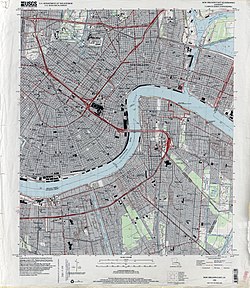
New Orleans is a consolidated city-parish located along the Mississippi River in the southeastern region of the U.S. state of Louisiana. With a population of 383,997 according to the 2020 U.S. census, it is the most populous city in Louisiana and the French Louisiana region; third most populous city in the Deep South; and the twelfth-most populous city in the southeastern United States. Serving as a major port, New Orleans is considered an economic and commercial hub for the broader Gulf Coast region of the United States.
Marie Catherine Laveau was a Louisiana Creole practitioner of Voodoo, herbalist and midwife who was renowned in New Orleans. Her daughter, Marie Laveau II, also practiced rootwork, conjure, Native American and African spiritualism as well as Louisiana Voodoo and traditional Roman Catholicism. An alternate spelling of her name, Laveaux, is considered by historians to be from the original French spelling.

Saint Louis Cemetery is the name of three Catholic cemeteries in New Orleans, Louisiana. Most of the graves are above-ground vaults constructed in the 18th and 19th centuries.

Streetcars in New Orleans have been an integral part of the city's public transportation network since the first half of the 19th century. The longest of New Orleans' streetcar lines, the St. Charles Avenue line, is the oldest continuously operating street railway system in the world. Today, the streetcars are operated by the New Orleans Regional Transit Authority (RTA).

Metairie Cemetery is a cemetery in southeastern Louisiana. The name has caused some people to mistakenly presume that the cemetery is located in Metairie, Louisiana, but it is located within the New Orleans city limits, on Metairie Road.

Hollywood Cemetery is a historic rural cemetery located at 412 South Cherry Street in the Oregon Hill neighborhood of Richmond, Virginia. It was established in 1847 and designed by the landscape architect John Notman. It is 135-acres in size and overlooks the James River. It is the only cemetery other than Arlington National Cemetery that contains the burials of two United States Presidents, James Monroe and John Tyler.

The Garden District is a neighborhood of the city of New Orleans, Louisiana, United States. A subdistrict of the Central City/Garden District Area, its boundaries as defined by the New Orleans City Planning Commission are: St. Charles Avenue to the north, 1st Street to the east, Magazine Street to the south, and Toledano Street to the west. The National Historic Landmark district extends a little farther.

Mitchell Joseph Landrieu is an American lawyer and politician who served as Mayor of New Orleans from 2010 to 2018. A member of the Democratic Party, he previously served as Lieutenant Governor of Louisiana from 2004 to 2010.
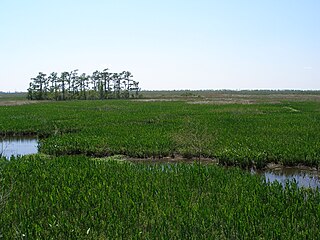
Jean Lafitte National Historical Park and Preserve protects the natural and cultural resources of Louisiana's Mississippi River Delta region. It is named after French pirate Jean Lafitte and consists of six separate sites and a park headquarters.

John McDonogh was an American entrepreneur whose adult life was spent in south Louisiana and later in Baltimore. He made a fortune in real estate and shipping, and as a slave owner, he supported the American Colonization Society, which organized transportation for freed people of color to Liberia. He had devised a manumission scheme whereby the people he held as enslaved could "buy" their own freedom, which took them some 15 years. In his will he provided large grants for the public education of children of poor whites and freed people of color in New Orleans and Baltimore, and by the 1970s some 20 schools in the New Orleans public school system were named for him.

The Times-Picayune/The New Orleans Advocate is an American newspaper published in New Orleans, Louisiana. Ancestral publications of other names date back to January 25, 1837. The current publication is the result of the 2019 acquisition of The Times-Picayune by the New Orleans edition of The Advocate in Baton Rouge, Louisiana.

Uptown is a section of New Orleans, Louisiana, United States, on the east bank of the Mississippi River, encompassing a number of neighborhoods between the French Quarter and the Jefferson Parish line. It remains an area of mixed residential and small commercial properties, with a wealth of 19th-century architecture. It includes part or all of Uptown New Orleans Historic District, which is listed on the National Register of Historic Places.
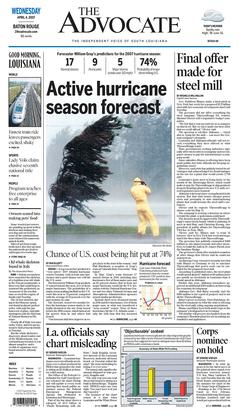
The Advocate is Louisiana's largest daily newspaper. Based in Baton Rouge, it serves the southern portion of the state. Separate editions for New Orleans, The Times-Picayune | The New Orleans Advocate, and for Acadiana, The Acadiana Advocate, are published. It also publishes gambit, about New Orleans food, culture, events, and news, and weekly entertainment magazines: Red in Baton Rouge and Lafayette, and Beaucoup in New Orleans.

William Harold Nungesser is an American politician serving as the 54th lieutenant governor of Louisiana since 2016. A member of the Republican Party, Nungesser is also the former president of the Plaquemines Parish Commission, having been re-elected to a second four-year term in the 2010 general election in which he topped two opponents with more than 71 percent of the vote. His second term as parish president began on January 1, 2011, and ended four years later.

The Robert E. Lee Monument, formerly in New Orleans, Louisiana, is a historic statue dedicated to Confederate General Robert E. Lee by American sculptor Alexander Doyle. It was removed (intact) by official order and moved to an unknown location on May 19, 2017. Any future display is uncertain.
Leslie Rosenthal Jacobs is an education reform advocate, business executive, and philanthropist. Born in New Orleans and a graduate of Cornell University, she built her family's small, independent insurance agency into one of the largest in the South, before merging the Rosenthal Agency with Hibernia National Bank. While President of Rosenthal Agency, Jacobs worked with the business community and the legislature to create the Louisiana Workers Compensation Corporation (LWCC) and served on its inaugural board of directors. The LWCC solved a state workers compensation crisis and today Louisiana has competitive and stable workers compensation rates. She went on to become a co-founder of Strategic Comp, a workers compensation insurance company that sold to Great American in 2008.
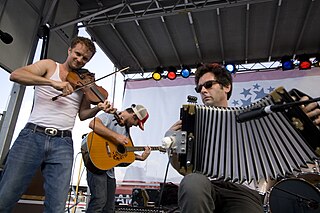
French Quarter Festival is a free, annual music festival held in early April, located in the historic French Quarter of New Orleans, Louisiana. Founded in 1983 with the first festival held in 1984, the festival features primarily New Orleans music, such as jazz, blues, and zydeco from hundreds of local musicians, as well as food from dozens of New Orleans restaurants.
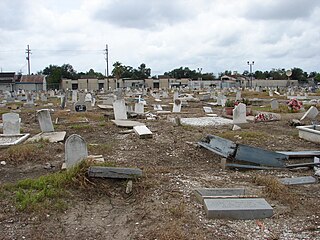
Holt Cemetery is a potter's field cemetery in New Orleans, Louisiana. It is located next to Delgado Community College, behind the right field fence of the college's baseball facility, Kirsch-Rooney Stadium. The cemetery is named after Dr. Joseph Holt, an official of the New Orleans Board of Health who officially established the cemetery in the 19th century. Holt Cemetery is one of the Historic Cemeteries of New Orleans.

The Historic Cemeteries of New Orleans, New Orleans, United States, are a group of forty-two cemeteries that are historically and culturally significant. These are distinct from most cemeteries commonly located in the United States in that they are an amalgam of the French, Spanish, and Caribbean historical influences on the city of New Orleans in addition to limitations resulting from the city's high water table. The cemeteries reflect the ethnic, religious, and socio-economic heritages of the city. Architecturally, they are predominantly above ground tombs, family tombs, civic association tombs, and wall vaults, often in neo-classical design and laid out in regular patterns similar to city streets. They are at times referred to colloquially as “Cities of the Dead”, and some of the historic cemeteries are tourist destinations.
As of February 2023, there were 7,150 electric vehicles registered in Louisiana.

